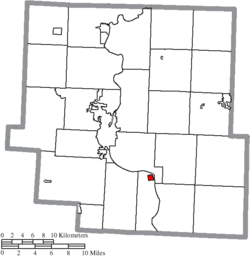Philo, Ohio facts for kids
Quick facts for kids
Philo, Ohio
|
|
|---|---|
|
Village
|
|

The previous bridge to Duncan Falls
|
|

Location of Philo, Ohio
|
|

Location of Philo in Muskingum County
|
|
| Country | United States |
| State | Ohio |
| County | Muskingum |
| Township | Harrison |
| Area | |
| • Total | 0.51 sq mi (1.33 km2) |
| • Land | 0.51 sq mi (1.33 km2) |
| • Water | 0.00 sq mi (0.00 km2) |
| Elevation | 755 ft (230 m) |
| Population
(2020)
|
|
| • Total | 720 |
| • Density | 1,406.25/sq mi (542.58/km2) |
| Time zone | UTC-5 (Eastern (EST)) |
| • Summer (DST) | UTC-4 (EDT) |
| ZIP code |
43771
|
| Area code(s) | 740 |
| FIPS code | 39-62442 |
| GNIS feature ID | 2399665 |
Philo (pronounced FY-loh) is a small village in Muskingum County, Ohio, United States. It is located right next to the Muskingum River. In 2020, about 720 people lived there. Philo is also part of the larger Zanesville micropolitan area, which means it's a smaller town connected to a bigger city nearby. It's also the closest town to Blue Rock State Park, a great place for outdoor activities.
Contents
History of Philo
Philo has an interesting past! It was first known by a different name: Taylorsville.
How Philo Got Its Name
The village of Taylorsville was started in 1833 by a man named James Taylor, and it was named after him. Later, in 1851, a post office opened there, and it was called Philo. The name Philo comes from an early settler named Philo Buckingham. So, the village eventually changed its name to Philo.
Philo Power Plant's Legacy
From 1924 to 1975, a very important power plant called the Philo Power Plant operated in the village. This plant made electricity for many people. In 1957, something special happened: Unit 6 at the Philo Power Plant became the first commercial supercritical steam-electric generating unit in the world! This was a big step forward in how power plants worked, making them more efficient.
Today, you can see parts of that historic Unit 6. The large spinning parts, called rotors, from Philo 6 are now a cool sculpture. This artwork was created by George Greenamyer and is on display at the AEP Building in Columbus, Ohio. It's a reminder of Philo's role in energy history.
Geography of Philo
Philo is a small village in terms of its size.
Village Area
According to the United States Census Bureau, the village covers a total area of about 0.42 square miles (1.09 square kilometers). All of this area is land, meaning there are no large lakes or rivers within the village limits.
Philo's Population Over Time
| Historical population | |||
|---|---|---|---|
| Census | Pop. | %± | |
| 1850 | 634 | — | |
| 1860 | 500 | −21.1% | |
| 1870 | 544 | 8.8% | |
| 1880 | 501 | −7.9% | |
| 1890 | 631 | 25.9% | |
| 1900 | 543 | −13.9% | |
| 1910 | 495 | −8.8% | |
| 1920 | 417 | −15.8% | |
| 1930 | 804 | 92.8% | |
| 1940 | 884 | 10.0% | |
| 1950 | 881 | −0.3% | |
| 1960 | 913 | 3.6% | |
| 1970 | 846 | −7.3% | |
| 1980 | 799 | −5.6% | |
| 1990 | 810 | 1.4% | |
| 2000 | 769 | −5.1% | |
| 2010 | 733 | −4.7% | |
| 2020 | 720 | −1.8% | |
| U.S. Decennial Census | |||
Philo's Population in 2010
In 2010, a census (a count of all the people) showed that 733 people lived in Philo. These people lived in 278 different homes, and 194 of these were families.
The village had about 1,745 people per square mile (673 people per square kilometer). There were also 320 housing units (like houses or apartments) in the village.
Most of the people living in Philo in 2010 were White (97.8%). A smaller number were African American (0.8%) or Asian (0.1%). About 0.7% of the population identified as Hispanic or Latino.
Households and Age in 2010
Out of the 278 households in Philo:
- About 41.7% had children under 18 living with them.
- 53.6% were married couples living together.
- About 24.5% of all households were made up of just one person.
- 12.6% of households had someone aged 65 or older living alone.
The average age of people in Philo in 2010 was 33.8 years old.
- Almost 30% of residents (29.7%) were under 18.
- About 26% (25.9%) were between 25 and 44 years old.
- About 12% (12.3%) were 65 years or older.
The population was pretty evenly split between genders, with 48.3% male and 51.7% female.
See also
 In Spanish: Philo (Ohio) para niños
In Spanish: Philo (Ohio) para niños

